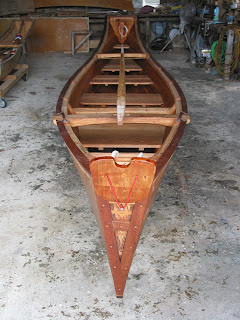Time seems to have taken on a strange quality the last week or so. I had two visitors from Tokyo over the last four days and it seems as though the first one was here a month ago. But in the midst of it all it seemed as though suddenly the boat was finished. And it is! The owner of a Shimojo san-built racing sabani in Itoman City is making the sail and it was decided that the material for our mast was too wet (and bent besides) so that part of the rig is still a work in progress.
It also feels as though I haven't posted to this blog in a long time. I will post here a selection of photos since we went back to work after New Years (on January 4th) and caption them. I will be here another week and no doubt find interesting things to blog about. Then I will keep readers posted as to the progress of writing my monograph about building this boat, preparing drawings, etc.
The subject of a launching ceremony is still up in the air, but if it happens and I see it, be assured I will post something here about it.
One of the jobs I was given was stripping the bark from a local cedar for our mast. I was given an old meat cleaver to do this. The drawknife, by the way, is completely unknown to Japanese boat builders, to the point where most have no idea what the tool is. Japanese barrel makers seem to be the only craftsmen who use this tool. The Japanese also have no native tool like the spokeshave.
Shimojo san determining where to cut the after beam out of a chunk of chage, the wood used to make the huundu fastenings. He would have used Okinawan pine, an amazingly dense wood, which we had used for the mast partners, but he didn't have enough of this material left.
Our rubrails are made of imported apetong. Shimojo san's son Tomio san is shown here nailing them to the planking.
We worked slowly down the hull, bending and nailing the rails. Their main function is to form a rubrail so that the handle of the paddles does not wear the soft cedar planking when paddling.
A cap made of cedar topped the stem transom.
Shimojo san fitted an intermediate beam, which was tenoned and fit in blocks that lay against the planking. The beam was inserted into one side then lowered down into the oversized tenon on the other side...
... then Shimojo drove it down tight using a bar wedged under one of our temporary beams...
... finally he wedged the tenon, which was cut off flush with the blocking.
Here is a look at the mast partners and the midships beam.
And a glimpse at the bow, showing the fastenings. Later this too got apetong rubrails.
I was put to work fitting and installing the thwarts in the boat. In the old days an eight meter sabani might have four to six fishermen. Shimojo san said that thwarts were once made of lashing together one inch diameter pieces of bamboo into a kind of rough mat. He added that this kind of seat was very uncomfortable to sit on, but fishermen didn't have much time to sit.
Our final two days the shop was like Santa's workshop, with Shimojo san finishing the beams, Tomio san working on the mast and rails, and me fitting thwarts.
Tomio san then took the job of shaping the mast.
Our last day of work my friend Tominaga san came from Tokyo. Here he is giving business cards to Shimojo san, his wife and oldest daughter.
Detail at the bow. The small curved beam is handy for attaching a line, but in earlier days this was actually a partner for a very small mast that was sometimes stepped in the bow. A small sail flown here slotted the wind, improving the efficiency of the main sail.
And now some shots of the finished boat, with a fresh coat of tempura oil (soybean based).

Shimojo san's bailer is a piece of sculpture in itself. He said that the knowledge of these is even rarer than that about sabani. Right after the War fishermen began using US Army helmets for bailers so these wooden bailers haven't been seen since then. Helmets then gave way to plastic buckets. Bailing was always important (the curve on the bottom of this bailer matches the curve in the bottom of our boat) because not only did sabani tip over, but sometimes fishermen intentionally tipped them over, riding out storms from underneath the hull. Knowing how to efficiently bail the boat was essential for fishermen. Today on Iejima an annual sabani race using three ceremonial boats (all built by Shimojo san) requires that each team paddle out of the harbor, then capsize their boat, then right and bail it before returning to the finish.

























































